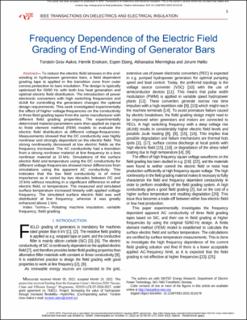| dc.contributor.author | Aakre, Torstein Grav | |
| dc.contributor.author | Enoksen, Henrik | |
| dc.contributor.author | Eberg, Espen | |
| dc.contributor.author | Mermigkas, Athanasios | |
| dc.contributor.author | Hølto, Jorunn | |
| dc.date.accessioned | 2022-11-03T11:31:36Z | |
| dc.date.available | 2022-11-03T11:31:36Z | |
| dc.date.created | 2022-10-17T12:51:32Z | |
| dc.date.issued | 2022 | |
| dc.identifier.issn | 1070-9878 | |
| dc.identifier.uri | https://hdl.handle.net/11250/3029851 | |
| dc.description.abstract | To reduce the electric field stresses in the end-winding in hydropower generator bars, a field dependent grading tape is applied in the transition zone from outer corona protection to bare insulation. The design is typically optimized for 50/60 Hz with both low heat generation and optimal electric field distribution. The introduction of power electronic converters with high switching frequencies and dU/dt for controlling the generators changes the optimal design requirements. This work investigated experimentally the effect of higher voltage-frequencies on the conductivity in three field grading tapes from the same manufacturer with different field grading properties. The experimentally determined material parameters were then applied as inputs to finite element method (FEM) models to evaluate the electric field distribution at different voltage-frequencies. Measurements showed that the DC conductivity was highly nonlinear and strongly dependent on the electric field. This strong nonlinearity decreased at low electric fields as the frequency increased. The AC conductivity had a transition from a strong nonlinear material at line frequency to a less nonlinear material at 10 kHz. Simulations of the surface electric field and temperature using the DC conductivity for different voltage frequencies showed minor differences from simulations using the apparent AC conductivity. This indicates that the low field conductivity is of minor importance as it varied by two decades between DC and 10 kHz without resulting in a significant difference in either electric field, or temperature. The measured and simulated surface temperature increased linearly with applied voltage frequency. The simulated surface electric field was well distributed at line frequency, whereas it was greatly enhanced above 1 kHz. | en_US |
| dc.description.abstract | Frequency Dependence of the Electric Field Grading of End-Winding of Generator Bars | en_US |
| dc.language.iso | eng | en_US |
| dc.publisher | IEEE | en_US |
| dc.title | Frequency Dependence of the Electric Field Grading of End-Winding of Generator Bars | en_US |
| dc.title.alternative | Frequency Dependence of the Electric Field Grading of End-Winding of Generator Bars | en_US |
| dc.type | Peer reviewed | en_US |
| dc.type | Journal article | en_US |
| dc.description.version | acceptedVersion | en_US |
| dc.rights.holder | © 2022 IEEE. Personal use of this material is permitted. Permission from IEEE must be obtained for all other uses, in any current or future media, including reprinting/republishing this material for advertising or promotional purposes, creating new collective works, for resale or redistribution to servers or lists, or reuse of any copyrighted component of this work in other works. | en_US |
| dc.source.journal | IEEE transactions on dielectrics and electrical insulation | en_US |
| dc.identifier.doi | 10.1109/TDEI.2022.3214178 | |
| dc.identifier.cristin | 2061991 | |
| dc.relation.project | EC/H2020/764011 | en_US |
| cristin.ispublished | true | |
| cristin.fulltext | postprint | |
| cristin.qualitycode | 1 | |
